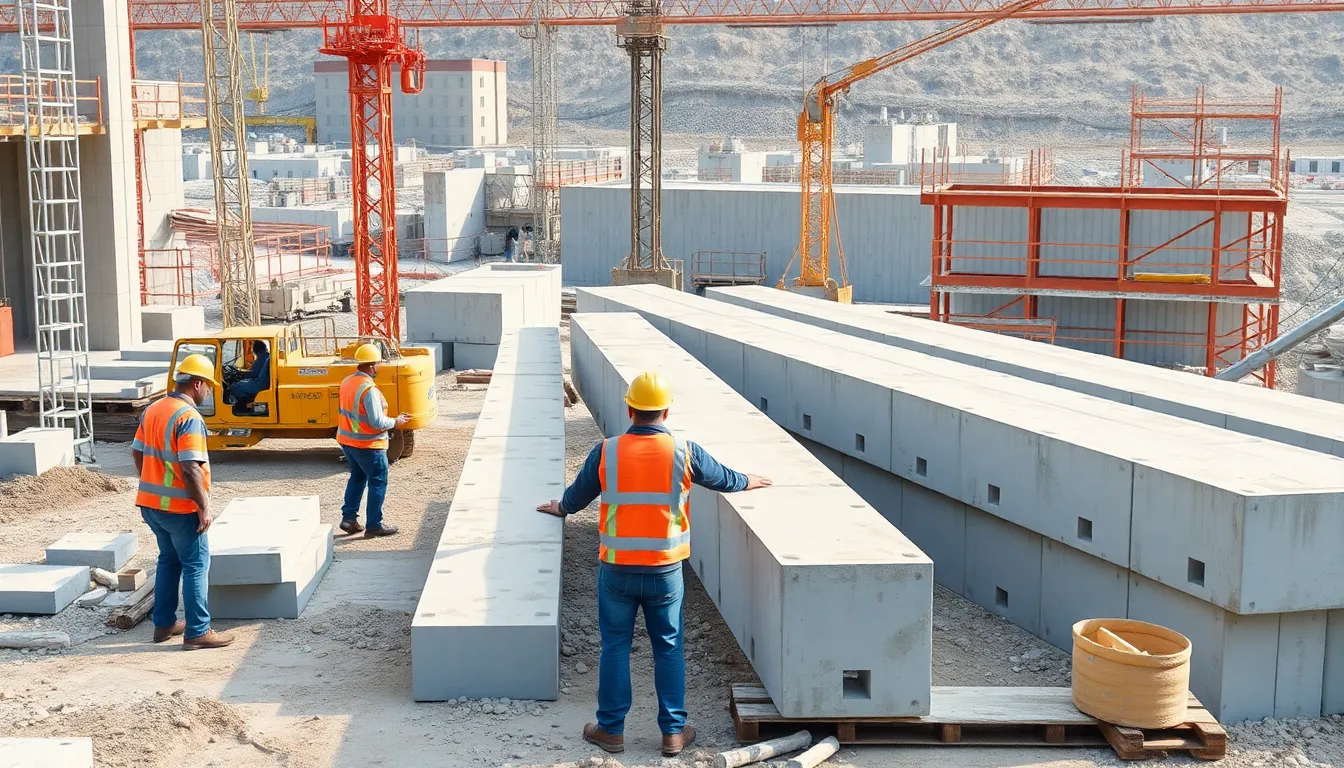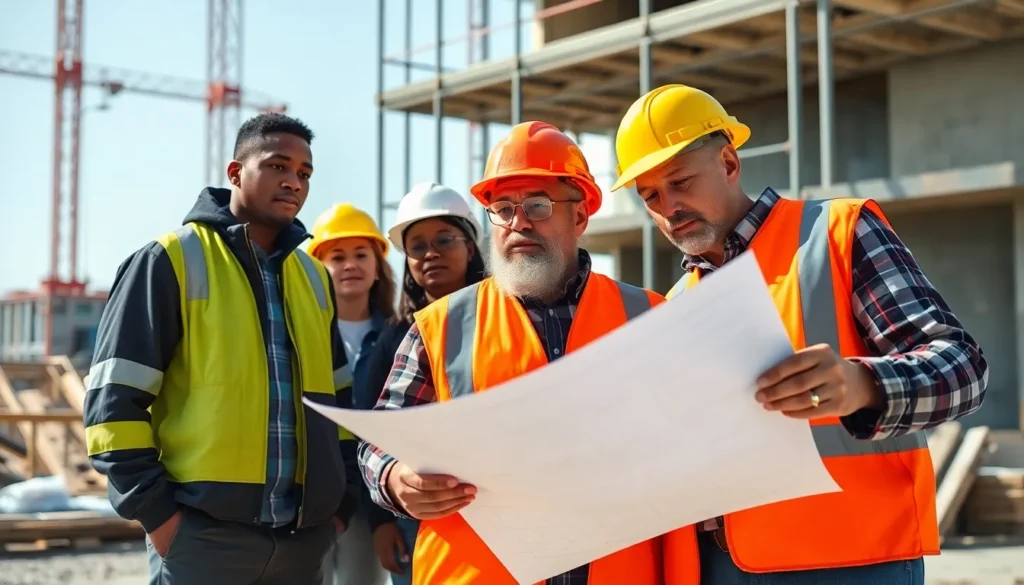Concrete building construction isn’t just about pouring a mix and hoping for the best. It’s a science, an art, and sometimes a game of patience that would make even a saint sigh. From skyscrapers that touch the clouds to cozy homes that withstand the test of time, concrete is the unsung hero of the construction world.
Table of Contents
ToggleOverview of Concrete Building Construction
Concrete building construction encompasses a variety of techniques and materials. The process includes site preparation, formwork, pouring, and curing. Each step requires careful planning and precise execution to ensure structural integrity.
Concrete serves multiple purposes, ranging from foundations to decorative elements. Its versatility allows for use in residential, commercial, and industrial structures. A well-designed concrete mix enhances durability and performance, supporting heavy loads and resisting environmental factors.
Attention to detail influences the overall quality of a concrete structure. Engineers and architects utilize advanced technology to analyze structural loads and foundation requirements. Concrete’s thermal mass properties contribute to energy efficiency in buildings, helping to regulate internal temperatures.
Construction methods vary significantly based on project scope and location. Modular concrete panels streamline construction timelines, while Insulated Concrete Forms provide energy-efficient walls. Mixing techniques also play a critical role, with options like ready-mix concrete or on-site batching.
Sustainability is becoming increasingly important in concrete construction. Recycled aggregates or alternative binders lower the environmental impact. Innovations like self-healing concrete enhance longevity and reduce maintenance costs, demonstrating how modern techniques improve traditional practices.
The finishing touches create aesthetically pleasing appearances in concrete structures. Techniques include stamping, staining, and polishing, offering a range of design options. Successful concrete construction relies on collaboration among engineers, contractors, and artisans to achieve desired outcomes.
Types of Concrete Used

Concrete construction employs various concrete types to optimize performance for different applications. Each type offers unique properties suited for specific demands.
Reinforced Concrete
Reinforced concrete incorporates steel bars or mesh to enhance tensile strength. This composite material provides structural support for large buildings, bridges, and foundations. Achieving high durability, it withstands heavy loads and extreme weather conditions. Engineers use reinforced concrete for seismic-resistant structures, ensuring safety during earthquakes. Its versatility allows it to fit diverse architectural designs, contributing to aesthetic appeal.
Precast Concrete
Precast concrete is manufactured offsite in a controlled environment. Components like walls, beams, and slabs are cast before being transported to the construction site. This method streamlines the building process, reducing on-site labor time. Precast concrete elements feature high strength and uniform quality, contributing to faster project completion. Delivery of these components ensures exceptional precision and reduces waste, which enhances overall project sustainability.
Lightweight Concrete
Lightweight concrete uses aggregates like expanded clay or shale to decrease density. Its lower weight reduces structural loads, making it ideal for high-rise buildings and roof systems. Also, lightweight concrete offers excellent insulation properties, enhancing energy efficiency. Application of this type decreases transportation costs due to its reduced weight. Its effective use in various construction scenarios demonstrates its growing popularity in modern building design.
Advantages of Concrete Building Construction
Concrete building construction offers numerous benefits that enhance both performance and sustainability.
Durability
Durability defines concrete structures, ensuring they withstand the test of time and environmental conditions. Concrete resists weathering, decay, and damage from pests. It supports heavy loads due to its compressive strength, making it suitable for skyscrapers and bridges. Reinforced concrete increases resistance to tensile forces, which is crucial for seismic zones. The low maintenance requirements of concrete further add to its longevity. Properties like fire resistance also contribute to building safety, helping structures remain intact during extreme conditions. A well-mixed concrete formulation enhances these durability factors, making concrete a preferred material in construction.
Energy Efficiency
Energy efficiency significantly improves in buildings constructed with concrete. Concrete’s thermal mass helps regulate indoor temperatures by absorbing heat during the day and releasing it at night. This quality reduces the reliance on heating and cooling systems, leading to lower energy bills. Using Insulated Concrete Forms can elevate energy efficiency levels even further, providing additional insulation. Effective energy management also results in a smaller carbon footprint over a building’s life. Many concrete mixes incorporate recycled materials, aligning with sustainable practices. The combination of these factors makes concrete a key player in creating energy-efficient structures.
The Concrete Construction Process
Concrete construction involves a systematic approach, integrating multiple steps that reinforce its quality and effectiveness.
Site Preparation
Site preparation forms the foundation for successful concrete projects. It entails clearing the area of debris, vegetation, and any existing structures. Once the site is clear, excavation begins, ensuring the ground reaches the proper depth and dimensions. Grading follows, leveling the surface to facilitate proper drainage and support for structures. Contractors often utilize heavy machinery to expedite these processes, ensuring precision and efficiency.
Foundation Laying
Foundation laying provides a strong base for concrete structures. Concrete footings are poured first, establishing stability for the walls or slabs above. Builders check the dimensions and depth of footings to comply with local codes and structural requirements. Reinforcement bars, commonly known as rebar, integrate into the concrete to enhance tensile strength. After preparation, concrete is poured into forms and carefully leveled for uniformity. Adequate curing ensures the foundation reaches optimal strength before further construction commences.
Structural Framework
Structural frameworks elevate the building above the foundation. Utilizing reinforced concrete, workers build walls, columns, and beams tailored to specific load requirements. Concrete forms help shape these elements during construction, allowing precise adjustments. The use of precast concrete elements may streamline the assembly process and enhance structural integrity. Quality control checks occur throughout to confirm alignment and uniform thickness. Each component contributes to the overall stability and safety of the structure, allowing for further additions and finishing touches.
Challenges in Concrete Building Construction
Concrete building construction faces several challenges that can impact both project timelines and overall costs.
Weather Conditions
Weather conditions play a significant role in concrete construction. Extreme temperatures, whether hot or cold, affect the curing process, leading to potential weaknesses in the concrete. High humidity can also result in complications, such as increased risk of efflorescence. Therefore, planning and scheduling construction activities around weather forecasts become essential for maintaining structural integrity. Utilizing protective measures, such as curing compounds or blankets, aids in mitigating negative effects during adverse weather. Proper adjustments in mix design can also enhance performance under varying climatic conditions.
Cost Considerations
Cost considerations are crucial in concrete building construction. Material expenses, labor rates, and equipment rental contribute significantly to the overall budget. Rising prices for raw materials, such as cement and aggregates, can strain financial resources. Effective project management, including detailed budgeting and regular monitoring, helps control costs. Innovative techniques, like using precast concrete elements, can streamline construction processes and reduce labor costs. Incorporating sustainable practices, such as utilizing recycled materials, not only lowers expenses but also aligns with environmental responsibilities. Balancing quality and cost remains a primary focus for successful project completion.
Concrete building construction stands as a testament to human ingenuity and craftsmanship. Its unique blend of durability and versatility allows for the creation of structures that not only meet functional needs but also aesthetic desires. As technology advances the industry continues to evolve with sustainable practices and innovative materials leading the way.
The importance of careful planning and execution cannot be overstated. Each phase from site preparation to finishing touches plays a critical role in ensuring the longevity and performance of concrete structures. By embracing these principles concrete construction will remain a cornerstone of modern architecture and urban development for years to come.









